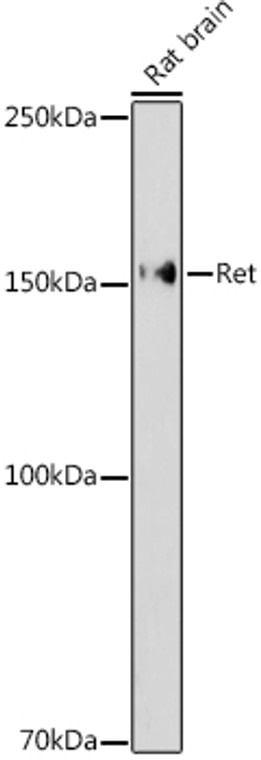| Host: |
Rabbit |
| Applications: |
WB/IF |
| Reactivity: |
Human/Mouse/Rat |
| Note: |
STRICTLY FOR FURTHER SCIENTIFIC RESEARCH USE ONLY (RUO). MUST NOT TO BE USED IN DIAGNOSTIC OR THERAPEUTIC APPLICATIONS. |
| Short Description: |
Rabbit polyclonal antibody anti-Ret (1000-1100) is suitable for use in Western Blot and Immunofluorescence research applications. |
| Clonality: |
Polyclonal |
| Conjugation: |
Unconjugated |
| Isotype: |
IgG |
| Formulation: |
PBS with 0.05% Proclin300, 50% Glycerol, pH7.3. |
| Purification: |
Affinity purification |
| Dilution Range: |
WB 1:500-1:1000IF/ICC 1:50-1:200 |
| Storage Instruction: |
Store at-20°C for up to 1 year from the date of receipt, and avoid repeat freeze-thaw cycles. |
| Gene Symbol: |
RET |
| Gene ID: |
5979 |
| Uniprot ID: |
RET_HUMAN |
| Immunogen Region: |
1000-1100 |
| Immunogen: |
A synthetic peptide corresponding to a sequence within amino acids 1000-1100 of human Ret (NP_066124.1). |
| Immunogen Sequence: |
DISKDLEKMMVKRRDYLDLA ASTPSDSLIYDDGLSEEETP LVDCNNAPLPRALPSTWIEN KLYGMSDPNWPGESPVPLTR ADGTNTGFPRYPNDSVYANW M |
| Post Translational Modifications | Autophosphorylated on C-terminal tyrosine residues upon ligand stimulation. Proteolytically cleaved by caspase-3. The soluble RET kinase fragment is able to induce cell death. The extracellular cell-membrane anchored RET cadherin fragment accelerates cell adhesion in sympathetic neurons. |
| Function | Receptor tyrosine-protein kinase involved in numerous cellular mechanisms including cell proliferation, neuronal navigation, cell migration, and cell differentiation upon binding with glial cell derived neurotrophic factor family ligands. Phosphorylates PTK2/FAK1. Regulates both cell death/survival balance and positional information. Required for the molecular mechanisms orchestration during intestine organogenesis.involved in the development of enteric nervous system and renal organogenesis during embryonic life, and promotes the formation of Peyer's patch-like structures, a major component of the gut-associated lymphoid tissue. Modulates cell adhesion via its cleavage by caspase in sympathetic neurons and mediates cell migration in an integrin (e.g. ITGB1 and ITGB3)-dependent manner. Involved in the development of the neural crest. Active in the absence of ligand, triggering apoptosis through a mechanism that requires receptor intracellular caspase cleavage. Acts as a dependence receptor.in the presence of the ligand GDNF in somatotrophs (within pituitary), promotes survival and down regulates growth hormone (GH) production, but triggers apoptosis in absence of GDNF. Regulates nociceptor survival and size. Triggers the differentiation of rapidly adapting (RA) mechanoreceptors. Mediator of several diseases such as neuroendocrine cancers.these diseases are characterized by aberrant integrins-regulated cell migration. Mediates, through interaction with GDF15-receptor GFRAL, GDF15-induced cell-signaling in the brainstem which induces inhibition of food-intake. Activates MAPK- and AKT-signaling pathways. Isoform 1 in complex with GFRAL induces higher activation of MAPK-signaling pathway than isoform 2 in complex with GFRAL. |
| Protein Name | Proto-Oncogene Tyrosine-Protein Kinase Receptor RetCadherin Family Member 12Proto-Oncogene C-Ret Cleaved Into - Soluble Ret Kinase Fragment - Extracellular Cell-Membrane Anchored Ret Cadherin 120 Kda Fragment |
| Database Links | Reactome: R-HSA-5673001Reactome: R-HSA-8853659Reactome: R-HSA-9768919 |
| Cellular Localisation | Cell MembraneSingle-Pass Type I Membrane ProteinEndosome MembranePredominantly Located On The Plasma MembraneIn The Presence Of Sorl1 And Gfra1Directed To Endosomes |
| Alternative Antibody Names | Anti-Proto-Oncogene Tyrosine-Protein Kinase Receptor Ret antibodyAnti-Cadherin Family Member 12 antibodyAnti-Proto-Oncogene C-Ret Cleaved Into - Soluble Ret Kinase Fragment - Extracellular Cell-Membrane Anchored Ret Cadherin 120 Kda Fragment antibodyAnti-RET antibodyAnti-CDHF12 antibodyAnti-CDHR16 antibodyAnti-PTC antibodyAnti-RET51 antibody |
Information sourced from Uniprot.org
12 months for antibodies. 6 months for ELISA Kits. Please see website T&Cs for further guidance









